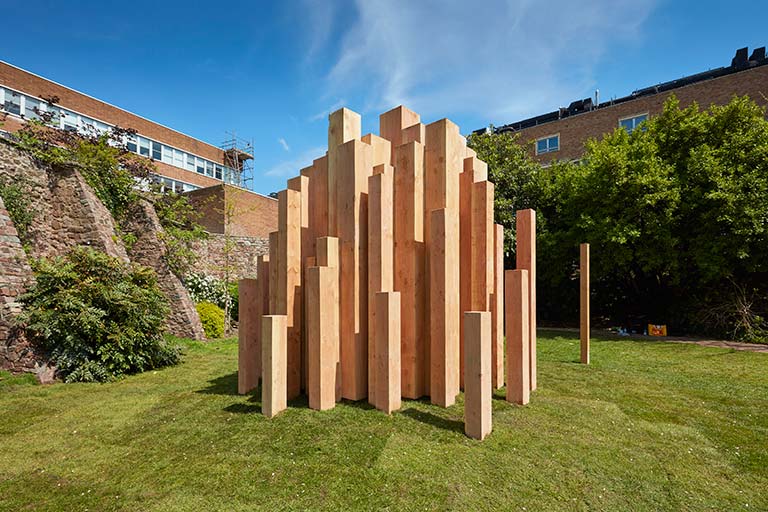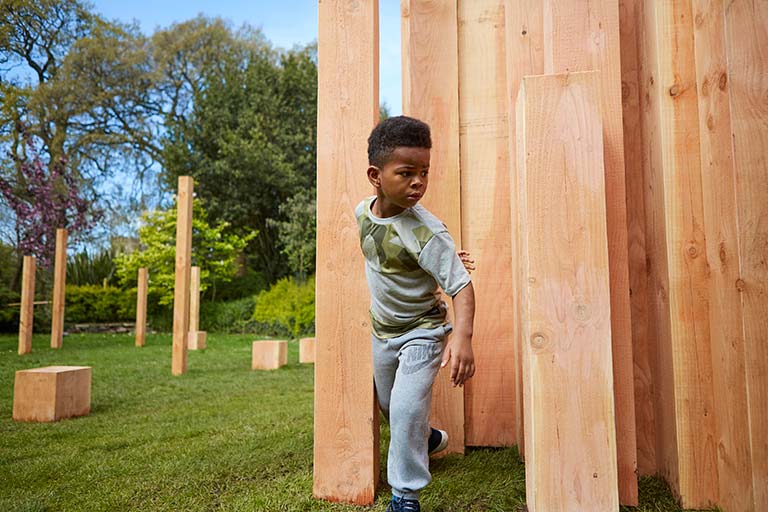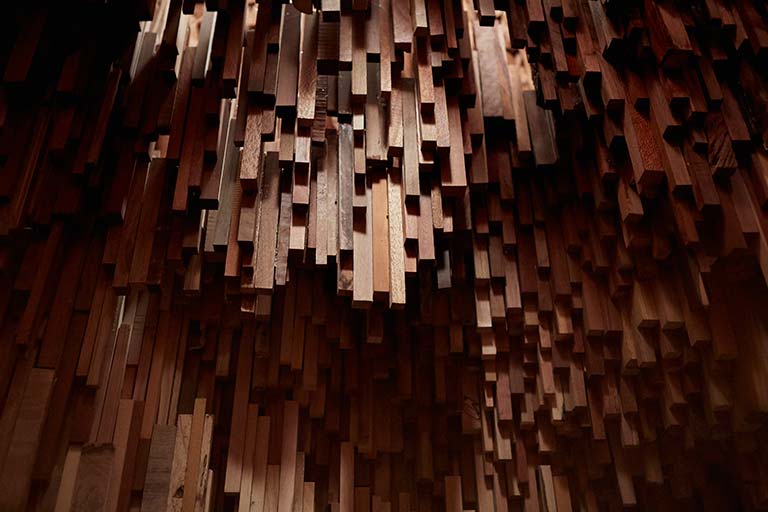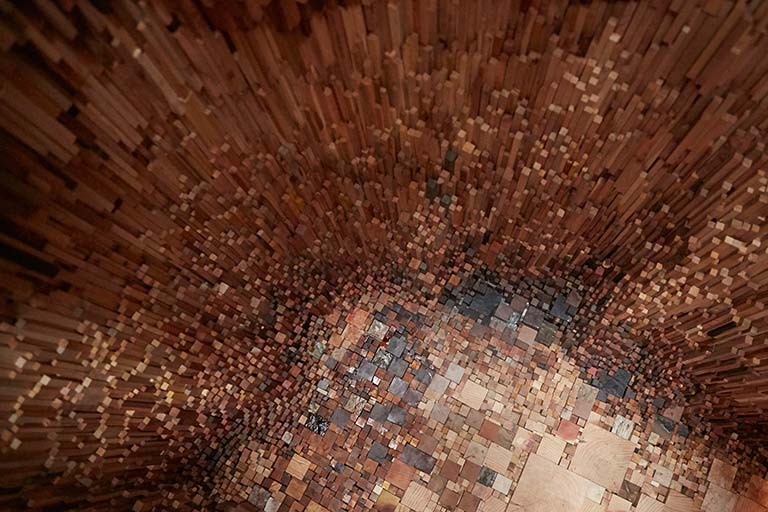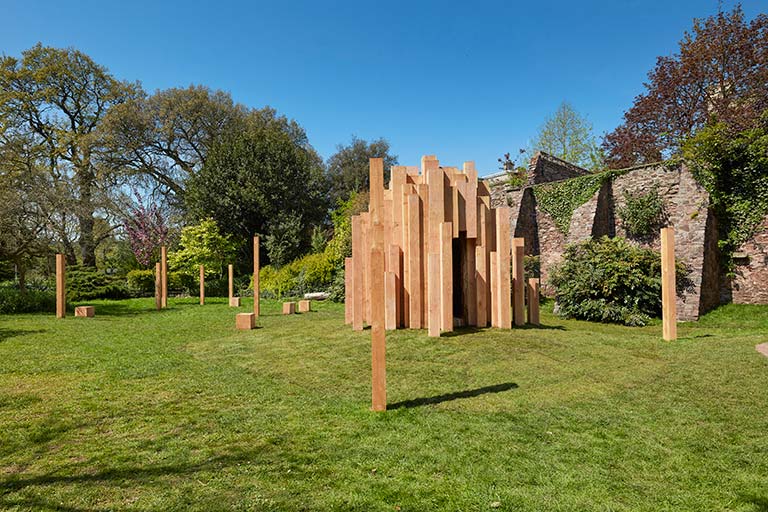






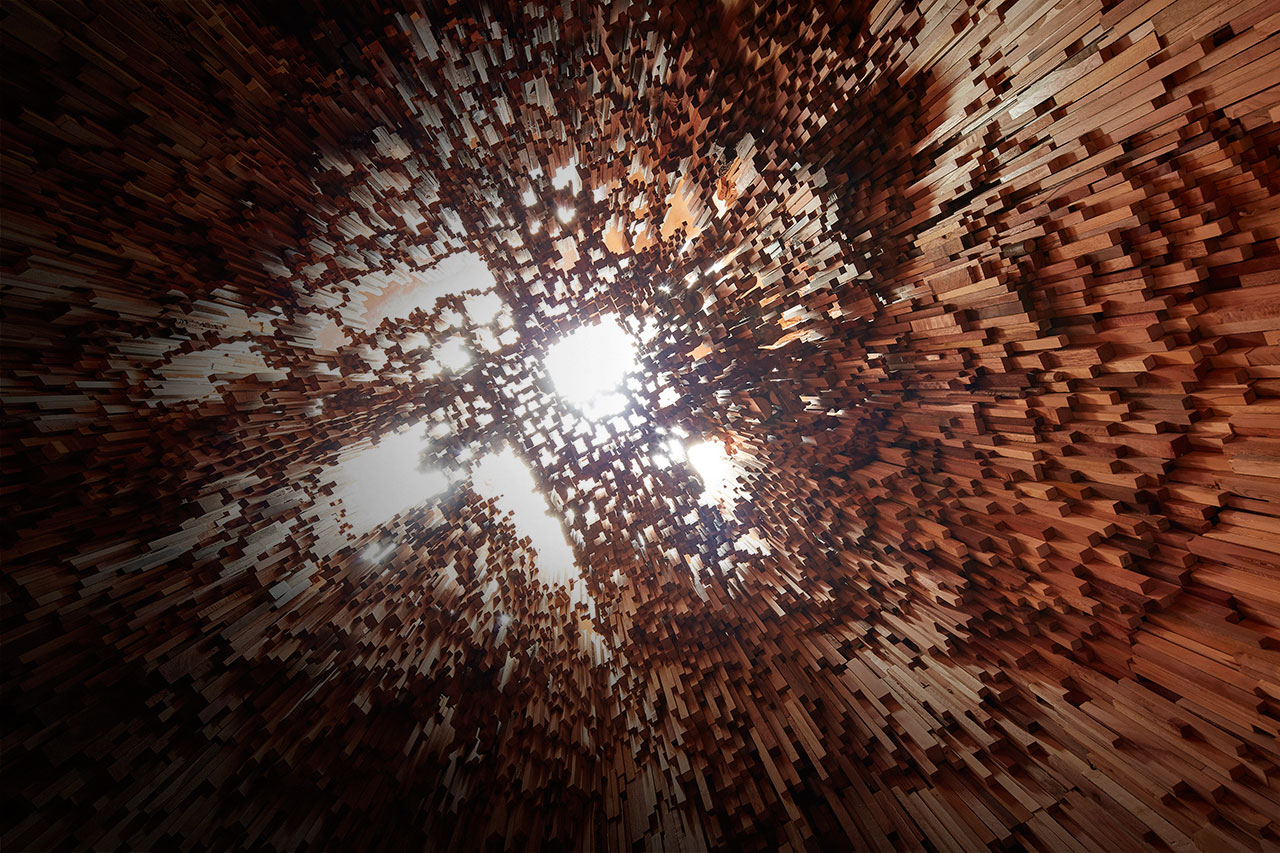
Discover a forest of all the world's trees
As you step inside Hollow you are surrounded by millions of years of evolution and human history. Listen, watch and explore more about Hollow and go deeper into the stories of the planet.
Hollow
Explore the history of the planet with artist Katie Paterson and Zeller & Moye and their public artwork for Bristol, UK.
By Katie Paterson and Zeller & Moye, Commissioned by the University of Bristol and produced by Situations
Hollow is a permanent public artwork created by artist Katie Paterson and architects Zeller & Moye and in association with members of the School of Biological Sciences for Bristols Royal Fort Gardens. Hollow houses a miniature forest of all the worlds trees.
Inside Hollow, you will discover over 10,000 unique tree species, which have been gathered by the artist from almost every country on the planet. Under your feet lie fossils, which span 390 million years, and above you thousands of unique tree samples connect across time and space, each with their own story to tell.
The relationship these trees have had with the environment, its water and its sunlight, and the plants, animals and fungi that lived with them, can be traced in the woods surfaces, once the living,
growing part of the tree: from the Indian Banyan Tree, under which the Buddha achieved enlightenment; to the Japanese Gingko tree in Hiroshima (a tree that witnessed and survived one of the darkest moments of human history); to common, but no less remarkable trees. Entering Hollow is to enter the history of our planet.
Hollow was commissioned in 2016 for Royal Fort Gardens in Bristol in South West England, to celebrate the opening of the University of Bristol's Life Sciences building. The University is renowned
internationally for its research in Life Sciences − addressing many of the acute challenges that currently face humanity, such as food security, the loss of biodiversity, and climate change.
This website offers the opportunity to explore the stories and responses to the artwork, to find out more about the artist, architects and partners involved. Click on ‘Experience Hollow’ to the right, to digitally explore each and every tree species contained within the artwork. Click on ‘Sculpture’ to scroll around a multidimensional view of the
interior; and ‘By piece’ to explore the full library of wood, either by common name, family type, or continent. Over 1,000 of the wood samples have stories to explore.
An introduction to Hollow





 Click to explore the different pieces
Click to explore the different pieces
As you step inside Hollow you are surrounded by millions of years of evolution and human history. Listen, watch and explore more about Hollow and go deeper into the stories of the planet.
The creation of Hollow was filmed for BBC Four's What Do Artists Do All Day? series. The documentary followed Katie Paterson over a ten-month period as she assembled the wood collection and created the artwork.
Watch the documentary below.
Watch the clip
Watch
As you enter Hollow all the world’s trees surround you. Locked within the samples of wood under your feet and above your head are many stories that explain the history of the planet. The tree samples can offer us clues to how we might tackle the challenges that face humanity; from food scarcity to climate change. Many of these trees have also witnessed pivotal moments in history that we can only imagine. Here two audio guides offer you the chance to consider these ideas in more depth and to unlock those stories hidden deep within Hollow.
Jon Bridle, Evolutionary Biologist, guides you through an inside view of Hollow, the evolution of species and the future of the planet.
Edson Burton, spoken word artist, takes you on a poetic journey through human history as witnessed by trees.
Listen
Imagine
As you step inside Hollow you are surrounded by millions of years of evolution and human history. Now enter a digital forest and get lost in the stories of trees from today.
Imagine in 50 years time what the landscape of the globe might look like? How many of the trees that surround us now will have become extinct or changed beyond recognition.
To accompany Hollow, Situations in association with BBC Get Creative, launched an open call to build a Treebank in just 50 days.
The result is a digital forest for the future, with stories, illustrations and memories of trees from today. Treebank is an interactive time capsule that preserves our living memory of trees offering a snapshot of the world’s biodiversity.
Follow the link below to explore Treebank:www.treebank.online
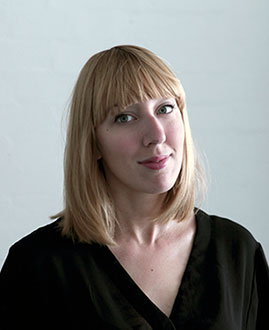
Collaborating with leading scientists and researchers across the world, Katie Paterson’s poetic and conceptual projects consider our place on Earth in the context of geological time and change.
Katie Paterson's make use of sophisticated technologies and specialist expertise to stage intimate, poetic and philosophical engagements between people and their natural environment. Combining a Romantic sensibility with a research-based approach and coolly minimalist presentation, her work collapses the distance between the viewer and the most distant edges of time and the cosmos.
Katie Paterson is regarded as an artist working at the forefront of her generation. She has exhibited internationally, from London to New York, Berlin to Seoul, and her works have been shown in major exhibitions including the Hayward Gallery, Tate Britain, Kunsthalle Wien, The Modern Art Museum of Fort Worth, and the Museum of Contemporary Art, Sydney. Her artworks are represented in
collections including the Guggenheim, New York and the Scottish National Gallery of Modern Art, Edinburgh.
Katie was winner of the Independent’s Creative 30 award “for Britain’s most creative young person” and the winner of the Visual Arts category of the 2014 South Bank Sky Arts Awards, and was recently awarded an Honorary Fellowship at Edinburgh
University in recognition of her ”major contribution in fostering collaboration between the arts and sciences”.
Katie Paterson www.katiepaterson.org

Zeller & Moye was founded by Christoph Zeller and Ingrid Moye as an architectural studio that operates with an interdisciplinary and global approach, with bases in Mexico City and Berlin.
The studio established a unique working method of extensive experimentation for the development of a project in order to articulate meaningful proposals for the contemporary world. Zeller & Moye has designed a wide range of projects at all scales from furniture design to large cultural buildings in different parts of the world.
Christoph Zeller and Ingrid Moye have been practicing architecture for more than 14 years
including work for international practices SANAA in Tokyo and Herzog & de Meuron in Basel and London, leading numerous projects such as the “Tate Modern Project” and the ”Serpentine Gallery Pavilion 2012”. Zeller & Moye are currently realising a memorial in Kurdistan, Iraq; a low-energy housing project in China; a design museum, two contemporary art galleries and a series of residential projects in Mexico; amongst others.
Christoph Zeller and Ingrid Moye teach at the AA Visiting Schools Berlin and Mexico, a master class in urban studies at the UIA Mexico City and have been jury members, lecturers and guest critics at various universities.
Zeller & Moye www.zellermoye.com

Downloads
Download a printed guidePlan your visit
Hollow is free to visit and open to all. Hollow is located to the right of the Tankard's Close entrance to the gardens. The gardens can also be accessed via the entrance on Tyndall Avenue, just follow the path to the other side of the gardens. There is level access into Royal Fort Gardens and the area around Hollow. The entrance to Hollow is narrow with a low step inside. The floor, which comprises fossil fragments, is uneven. The interior is naturally lit and therefore may be dim on cloudy days or at dusk. We would advise only one or two people at a time enter Hollow to fully experience the work. Please tread carefully.
Opening hours
Royal Fort Gardens are open every day of the year and the interior of Hollow is open during daylight hours. Opening times may vary during the summer months and holidays are at the discretion of the University of Bristol.
After your visit, share your experience with us on Facebook, Twitter and Instagram using the hashtag #BristolHollow
Visit Hollow, Royal Fort Gardens, Bristol
Created by Katie Paterson and Zeller & Moye. Commissioned by the University of Bristol and produced by Situations. Funded by the University of Bristol and Arts Council England.
University of Bristol, Life Science department
www.bristol.ac.uk/lifesciencesThe £56.5 million Life Sciences building, opened by Sir David Attenborough in October 2014, is the University’s biggest construction project to-date and signifies its commitment to biological sciences research.
Situations
www.situations.org.ukSituations is an arts organisation dedicated to commissioning and producing compelling and imaginative new forms of public art. For over a decade we have been supporting artists to make extraordinary ideas happen in unusual and surprising places, directly engaging in people’s lives and offering alternative ways in which to see, hear and connect to each other. In recent years, Situations has sparked a gold rush in Folkestone, UK (Michael Sailstorfer,
Folkestone Digs, 2014); towed an Arctic Island around the South West coast of England for the London 2012 Cultural Olympiad and gained 23,000 new citizens of the newly declared island nation (Alex Hartley, Nowhereisland, 2012) and sustained a continuous programme of performance for 552 hours with 1,000 performers in the ruin of Temple Church, Bristol (Thesater Gates, Sanctum, 2015). Situations is an Arts Council England National Portfolio organisation and is generously supported
by the Esmée Fairbairn Foundation, the John Ellerman Foundation and the University of the West of England, Bristol. If you’d like to find out more about Situations, sign up to our mailing list.
Situations mailing listMilimetre Ltd.
www.millimetre.uk.netFabricated by Millimetre Ltd
Website
Web design by Hello Monday.
Sound by Adam Asnan and Carlo Amadio.
Thanks to
With heartfelt thanks —
To Robert Ritchie in Canada for contributing his life’s wood collection to the project.
To Rachel Cartwright for painstakingly archiving the entire collection.
To Mark Nesbitt at Kew for his support and guidance.
To Gary Foster, Simon Hiscock, Jon Bridle and Heather Whitney and students from the School of Biological Sciences for their advice and insight.
To Hello Monday for creating this beautiful website, and to Adam Asnan and Carlo Amadio for their evocative sound composition.
We acknowledge the guidance and support of past and present members of the University of Bristol Public Art Committee, the team at Situations, Zeller & Moye and the team at Katie Paterson Studio for their commitment to the development of this work over three years. Thanks also to Arnolfini for hosting the sorting of the wood collection in December 2015.
Collaborators
We are proud to have collaborated with a network of research institutions and arboretums around the world. Our sincere thanks to —
Ardkinglas Estate, Argyll, UK
The Arnold Arboretum of Harvard University; USA
Bedgebury National Pinetum, UK
Department of Wood Science & Engineering Xylarium, Oregon State University, USA
Herbario Nacional de México, Mexico
Keele University Arboretum, UK
Laboratory of Wood Anatomy and Xylarium of CNR-IVALSA National Research Council of Italy. Trees and Timber Institute. Italy
The National Botanic Garden of Wales, UK
The Pennsylvania State University, USA
Research Institute for Sustainable Humanosphere, Kyoto University, Japan
Royal Botanic Gardens Edinburgh, UK
Herbarium, Royal Botanic Gardens, Kew, UK
Teruven Wood Xylarium, The Royal Museum for Central Africa, Belgium
University of Bristol, Department of Life Sciences, UK
USDA Forest Service, Forest Products Laboratory, USA
Westonbirt, The National Arboretum, UK
Winkworth Arboretum, UK
University of Hull, UK
Yorkshire Arboretum, UK
Allan Schwindt
Barry & Danielle James
Col Martin
Dennis Brett
Dennis Wilson
Evelyn Dixon
Gary Green
Henk Bakker
James R. Coleman
Lionel Daniels
Manuel Soler
Rejean Drouin
Robert Ritchie
Acknowledgements



